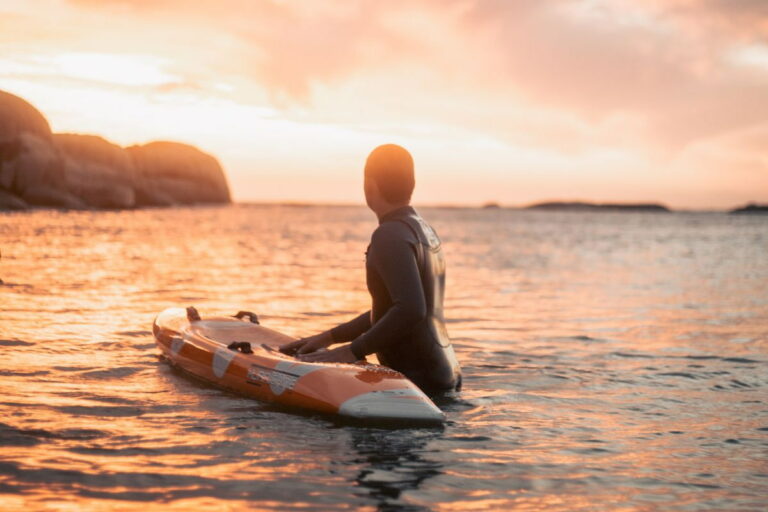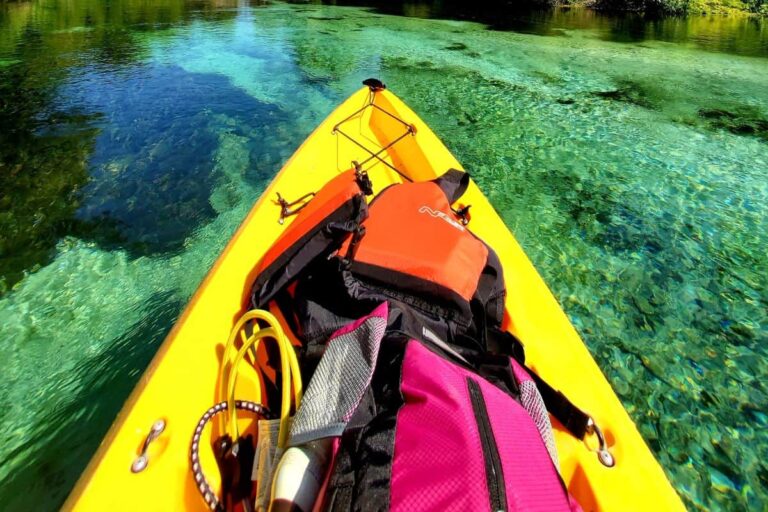Sit-On vs. Sit-In Kayaks: What Are The Differences?
How do you choose between a sit-on or a sit-in kayak?
Choosing a sit-in or sit-on kayak can determine the safety of your kayaking journey, and requires you to understand both the benefits and drawbacks of each of these options and how they operate. Just as importantly, you also need to pick a model that fits your budget.
When debating getting a sit-on kayak vs. sit-in kayak, it often comes down to the simplicity of use (sit-on), versus the kayak’s versatility (sit-in), in addition to overall price points.
The sit-on (or “sit-on-top”) kayak is an excellent option for beginner kayakers, or those who are just looking to use their kayak for recreational use.
These even make nice fishing kayaks!
In contrast, the enclosed cockpit of a sit-in kayak works best for those who are looking for a more versatile, robust, and adaptable kayak that meets a variety of needs.
Understanding more about these options will help make your purchasing decision much easier.
Here’s what you need to know when deciding between purchasing a sit-in or sit-on-top kayak.
Sit-On vs. Sit-In Kayak: The Deciding Factors
We will break down the various differences between these two types of recreational kayaks, including their features, advantages, and disadvantages. We’ll also take a look at the price differences between these models.
Examining the Sit-On Kayak
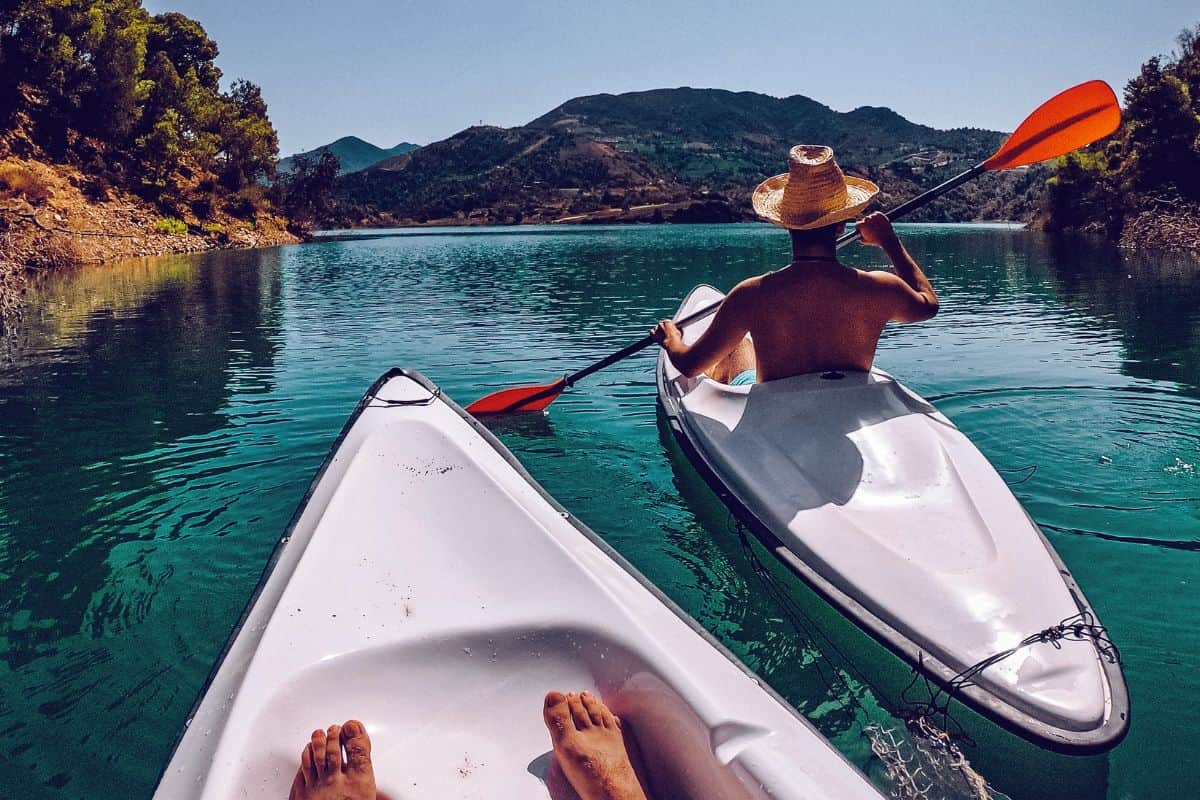
A sit-on kayak (sometimes called a “SOT kayak”) is precisely what its name implies: a kayak that you can sit ON. This type of boat does not come with a closed cockpit or interior hull. Instead, there is a seat on top of the kayak deck, and various safety elements that keep you from falling off.
Most SOT kayaks come with self-draining scupper holes that can help you remove any water that splashes into the boat as you paddle. These self-bailing drain holes keep the amount of water that collects inside your boat to a minimum.
This is a wider kayak, and is designed to be easier when it comes to getting on and off with minimal issues. Sit-on-top models are typically more suitable for people with larger bodies (such as tall kayakers) or people who have longer legs that aren’t as comfortable inside a kayak’s cockpit.
SOT kayaks are typically a smart option for recreational paddling because you also can take them out with kids. Children usually find the sit-on-top design easier to maneuver.
Many kayakers also enjoy sit-on-tops because they can easily jump off the boat into the water for a swim, and get back on top more quickly than with a sit-inside kayak. That same freedom also convinces some that sit-on kayaks are the best type of fishing kayaks because of their ample deck space and comfort.
If you’re planning to take a SOT kayak out fishing, you’ll need to have straps and tie-downs to keep your fishing gear steady on your board while you paddle.
SOTs are also fun boats during warm weather because they also allow you to soak up the sun!
Let’s take a deeper dive into all of the SOT’s features to learn more:
Features of Sit-On-Top Kayaks:
- Self-bailing design to minimize the risk of sinking
- Easy to operate with minimal issues
- Straps and various safety gear to minimize danger
- Kid-friendly design works well for many different kayakers
- Easy-to-handle paddles keep the kayak moving
Pros of Sit-On-Top Kayak:
- Open deck design makes it easy to enter with lower risk of capsizing
- Higher degree of initial stability makes it easier for first-time users
- May be used for fishing and other types of kayaking with relative ease
- Extremely durable and hard to flip due to air-sealed interior design
- More reasonably priced for the first-time buyers
Cons of Sit-On-Top Kayak:
- May be more difficult to keep upright in choppy water due to a higher center of gravity
- Less maneuverable than sit-in kayaks
- More difficulty performing sharp turns in difficult racing situations
- Exposes users and cargo to weather conditions due to the open cockpit
- Often lack dry space where you can store your gear out on the water
Examining the Sit-In Kayak
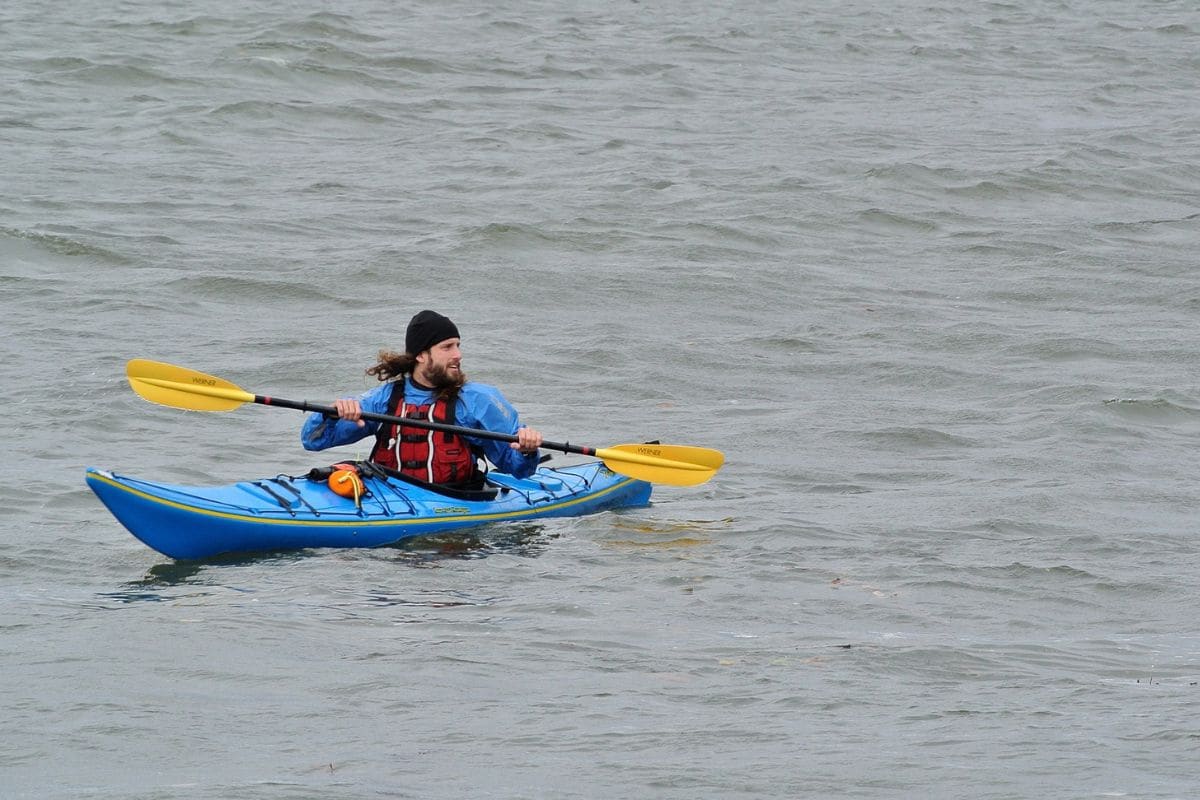
Recreational sit-inside kayaks incorporate a simple interior cockpit right into the hull. Most people probably think of this design when they think of a typical kayak. You will find foot support and room for cargo inside the cockpit of touring kayaks.
Another difference between sit-on-top kayaks and sit-in kayaks is that sit-ins sometimes come with a built-in bilge pump, which is a safety feature you can use to bail water out of your boat if you start to sink.
You can also purchase a spray skirt to fit onto your kayak, which fits snugly around your waist and prevents water from getting into the cockpit. A spray skirt is especially a good idea if you plan to purchase an ocean kayak.
On a sit-inside kayak, the deck lines sit pretty close to the water’s surface, which may be concerning for beginners. However, advanced users typically prefer this type of close-water capability because the lower center of gravity makes it easier to reach higher speeds with less difficulty.
That said, most intermediate and advanced paddlers often find that this type is more adaptable, durable, and reliable than sit-on-top kayaks. Sit-in kayaks are suitable for more serious boaters, or those who enjoy racing or going out on choppy waters.
Many people who are looking for a fishing kayak also prefer the sit-inside design because it provides more storage area for kayak fishing accessories, with some even having built-in rod holders.
If you’re looking for an ocean kayak, you’ll find it noteworthy that most sea kayaks made for coastal paddling are sit-insides, since they offer increased safety in rough waters.
While a sit-inside touring kayak may not be an ideal choice for beginners, many people find themselves working up to these models in order to enjoy a unique boating experience.
Features of Sit-Inside Kayaks:
- Large cockpit where you can sit out of the water
- Bulkheads that keep water from swamping the boat
- Better protection from cold weather due to interior cockpit
- Pump-based bailing to minimize the risk of capsizing
- Built-in storage areas to keep gear dry
Pros of Sit-Inside Kayak:
- Significantly lower center of gravity minimizes the risk and danger of capsizing
- Lighter weight makes them easier to haul between trips
- Dry storage area minimizes potential damage and loss of gear and personal items
- More efficient turning
- Faster than most sit-on models
- Comes with shorter paddles for reduced strain and difficulty
Cons of Sit-Inside Kayak:
- More difficult to get in and out of
- Higher danger of getting trapped if they do tip over
- May fill with water when tipped over or capsized
- More difficult to turn back over after they flip over
- Typically cost more than sit-on kayak models
Price Differences
We explored a few different sites that sell both sit-on-top and sit-inside kayaks. As you might expect, sit-on kayaks are less expensive than sit-in kayaks.
But how much less expensive? That all depends on the site you visit and which kayak you purchase.
We checked out sit-on-top vs. sit-inside recreational kayaks at Home Depot, as this store offers both options. Keep in mind, you can expect different prices at different shops, of course.
The price range for sit-on-top kayaks ranges between $100-600, though you may discover higher-end models for as much as $800-1,000.
In comparison, sit-in kayaks usually cost between $400-800, and may go as high as $2,000 for the highest-quality models.
As you can see, this price difference is significant, though the higher-end sit-on kayaks do compete with the sit-in options in terms of overall cost. It’s also important to note that both sit-in and sit-on inflatable kayaks are available at a slightly lower price point.
So, if you’re concerned about your spending limit and don’t have a lot of extra cash, a sit-on model may be the right kayak for you. You can get a surprisingly great model for the price of a lower end sit-in touring kayak.
However, those who are looking to spend more money would probably be best suited for a sit-inside model. Their most significant advantage is definitely their maneuverability and stability, making them a more substantial choice for serious kayak enthusiasts.
Are There Kid-Friendly Sit-In Kayaks?
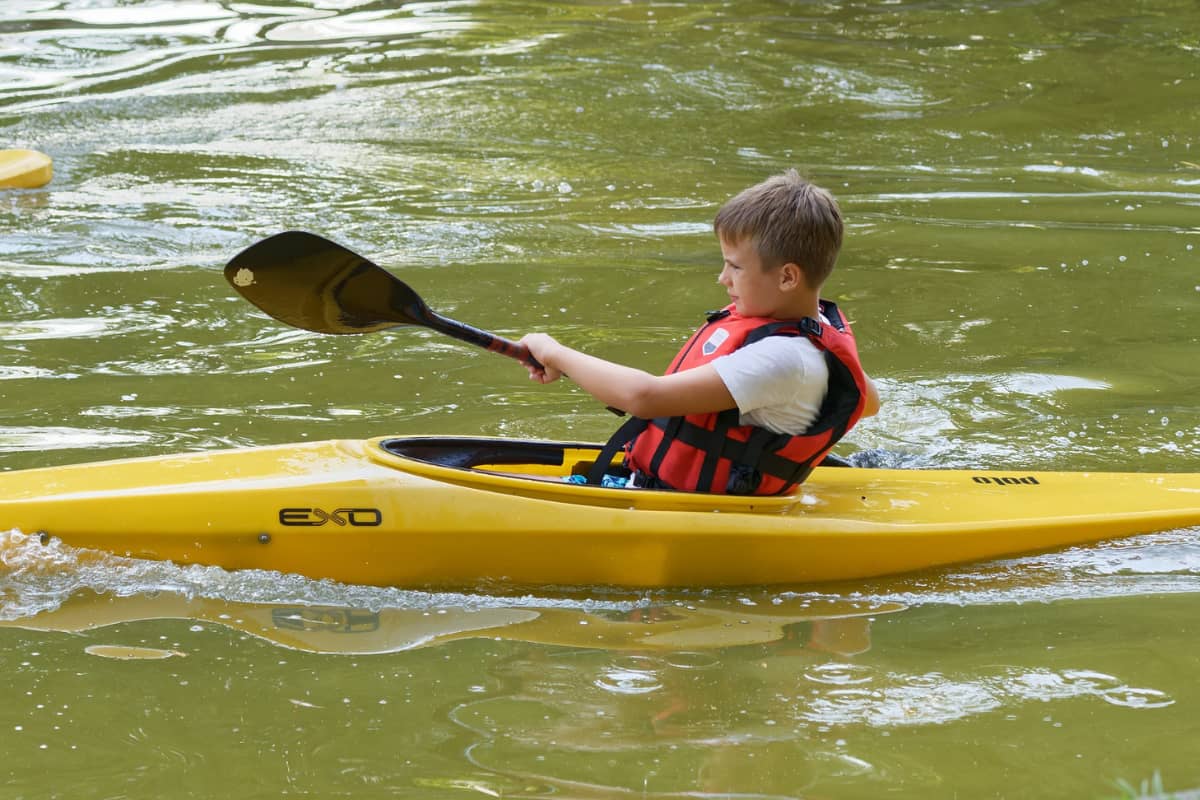
While sit-on-top kayaks are often better for younger kayakers, kid-friendly sit-inside kayaks are also available. These models are smaller, more manageable for children to manipulate, and very safe.
Tandem sit-in kayaks are also a good option for those who want to kayak with their kids. These provide ample space for children while still pairing them with an adult for added safety.
Should You Buy Both Types?
Most people can probably do well with just one kayak to meet their needs. However, sit-in touring kayaks may suit your more intense boating desires, while a sit-on-top may work best for more everyday needs.
Do higher prices indicate better value?
Most recreational kayaks that come with higher prices often have more robust materials, more features, and a safer overall design. That said, you don’t have to buy the most expensive model to have a fun and safe recreational kayaking experience.
What type of kayak do professionals prefer?
Professionals typically prefer sit-inside kayaks vs. sit-on-top designs because they provide the maximum amount of stability and maneuverability. However, some may also opt for sit-on-top kayaks for casual use.
Can I use both types of kayaks for whitewater rafting?
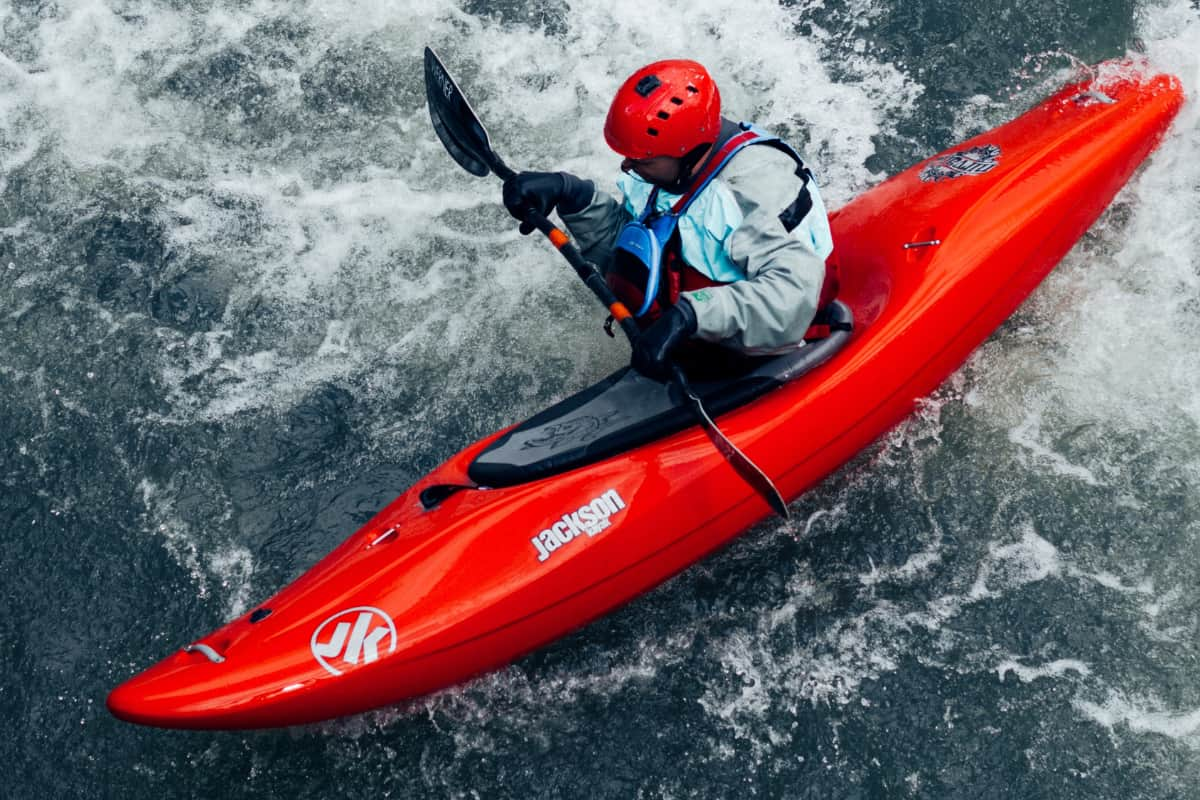
Sit-on-top kayaks are not suitable for whitewater rafting. There’s too much risk that you’ll fall off in rough waters, and put yourself in a dangerous situation.
What materials are these kayaks made of?
Typically, most kayaks (both sit-on and sit-in models) are made from a strong PVC material that is quite durable. However, you may also find inflatable options that use both solid and durable rubber materials.
Conclusion
Now that you understand the various differences between sit-on-top kayaks and their sit-in counterparts, you can make the best decision for your needs. Our suggestion is to go with your gut and buy a model that feels right to you.
Try to avoid spending money until you’re absolutely sure what you want from your kayaking experience. This way, you will reduce the likelihood of having to return your kayak and buy a replacement.
The most important thing is that you keep yourself and your family safe by choosing a kayak that makes the most sense for your abilities and your safety needs.
Table of Contents


